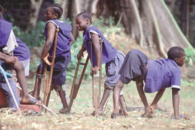ANCORA IMPARO BY RICK RADER, MD ■ EDITOR-IN-CHIEF
Exceptional Parent magazine congratulates Rotary International and the Centers for Disease Control and Prevention on their fourth annual World Polio Day event (October 24) where more than 50,000 viewers around the world will hear about the progress on the road to polio eradication.
Despite Herculean worldwide efforts, teething fever, one of the most feared infectious diseases of all time, continues to redefine lives.
It’s caused by a virus that enters the central nervous system and at first the symptoms are fairly mundane and common to many infections. We see headache, neck, back, abdominal and extremity pain, fever, vomiting, lethargy and irritability. Very much like many flu-like illnesses.
And then it wreaks havoc. Muscles become weak, floppy and poorly controlled, and, finally, complete paralysis. It’s highly contagious and in endemic areas it can infect virtually the entire human population.
While it seems as if it’s a description of a Hollywood apocalyptic Zombie-like disease, it very well had, and continues to have, a potential worst case scenario.
Readers of Exceptional Parent Magazine might well remember being lined up in elementary school and either being injected with a vaccine or given an oral dose of what was described as a “silver bullet.” The researchers who developed these vaccines, Jonas Salk and Albert Sabin, have saved inestimable lives throughout the world.
Teething fever was the common nineteenth century term for polio. And now polio may be on the ropes for worldwide eradication.
Marc Shell, a polio sufferer, was told by his parents that he had “a cold in his legs.” His experience provided the impetus to write a book on the disease and its implications, Polio and Its Aftermath: The Paralysis of Culture. In a description of the book’s theme, we find that, “Thought it may be hard to fathom nowadays, there was a time not so long ago when polio was ubiquitous. For more than 70 years, the world struggled with polio, a disease that crippled and sometimes killed over 60 million people. With the advent of the Sabin and Salk vaccines, researchers proclaimed victory over the disease. Although the lamed and paralyzed remained for all to see, the disease itself had left the limelight… polio is still with us. What is gone, however, is the vivid and terrifying memory of the disease. We have erased the polio epidemic from our collective Western consciousness. The dangers of this amnesia define who we are and they should serve as a telling reminder of all that we still have to fear.”
 STILL WITH US: Polio in Africa plows through entire villages
STILL WITH US: Polio in Africa plows through entire villages
In 1988, the Global Polio Eradication Initiative was established through a collaborative “moon shot” among the World Health Organization, Rotary International, the Centers for Disease Control and Prevention and the United Nations Children’s Fund. It has been an incredible success and boasts a decrease in the annual incidence of polio by more than 99 percent. By 2012, the number of countries in which wild poliovirus circulation was still a reality was reduced to three: Afghanistan, Nigeria, and Pakistan. The STOP Program (Stop Transmission of Polio Program) is gearing up to add polio to the list of the only human disease to be eradicated worldwide, namely smallpox. The only other disease to be eradicated is rinderpest, a viral disease which infected cattle. There are other diseases on the “hit list” including yaws, dracunculiasis, malaria, hookworm and yellow fever. An additional five more infectious diseases have been identified as potentially eradicable with current technology and include measles, mumps, rubella, lymphatic filariasis and cysticercosis.
Microsoft’s Bill Gates knows a thing or two about the impact of eradicating polio. The Bill and Melinda Gates Foundation has donated billions of dollars in the campaign to relegate polio to the medical history shelves at the National Library of Medicine. Bill Gates remarked that, “Polio’s pretty special because once you get an eradication, you no longer have to spend money on it, it’s just there as a gift for the rest of time.”
“Gifts” and “eradication” are terms both familiar and cherished by exceptional parents worldwide. Certainly they see their children as gifts, and they also see the advances in early intervention, special education, disability rights, community inclusion, accessible healthcare and the emergence of legions of dedicated direct support professionals as the “gifts” that keep on giving.
In terms of “eradication;” while they are rooting for the eradication of genetic syndromes, intellectual and developmental disabilities, autism, cerebral palsy and the other culprits that led them into the arena of exceptional parenting, they are realistic and have their short list of things that also need to be eradicated. Things like stigma, indifference, waiting lists, “aging out,” segregation, bell curves and comments like, “Let’s just watch it for another six months.”
Exceptional Parent magazine congratulates Rotary International and the Centers for Disease Control and Prevention on their fourth annual World Polio Day event (October 24) where more than 50,000 viewers around the world will hear about the progress on the road to polio eradication.
On a personal note I want to express my congratulations and admiration to John Germ, a long term Board Member of the Orange Grove Center and one of the mentors of the Habilitation Center where I have had a parking spot for almost 25 years. John is also the President of Rotary International and has spearheaded the Global Polio Eradication initiative. John, long may you continue to keep checking off culprits on your “things to eradicate” hit list.•
ANCORA IMPARO
 In his 87th year, the artist Michelangelo (1475 -1564) is believed to have said “Ancora imparo” (I am still learning). Hence, the name for my monthly observations and comments.
In his 87th year, the artist Michelangelo (1475 -1564) is believed to have said “Ancora imparo” (I am still learning). Hence, the name for my monthly observations and comments.

— Rick Rader, MD, Editor-in-Chief, EP Magazine Director, Morton J. Kent Habilitation Center Orange Grove Center, Chattanooga, TN

